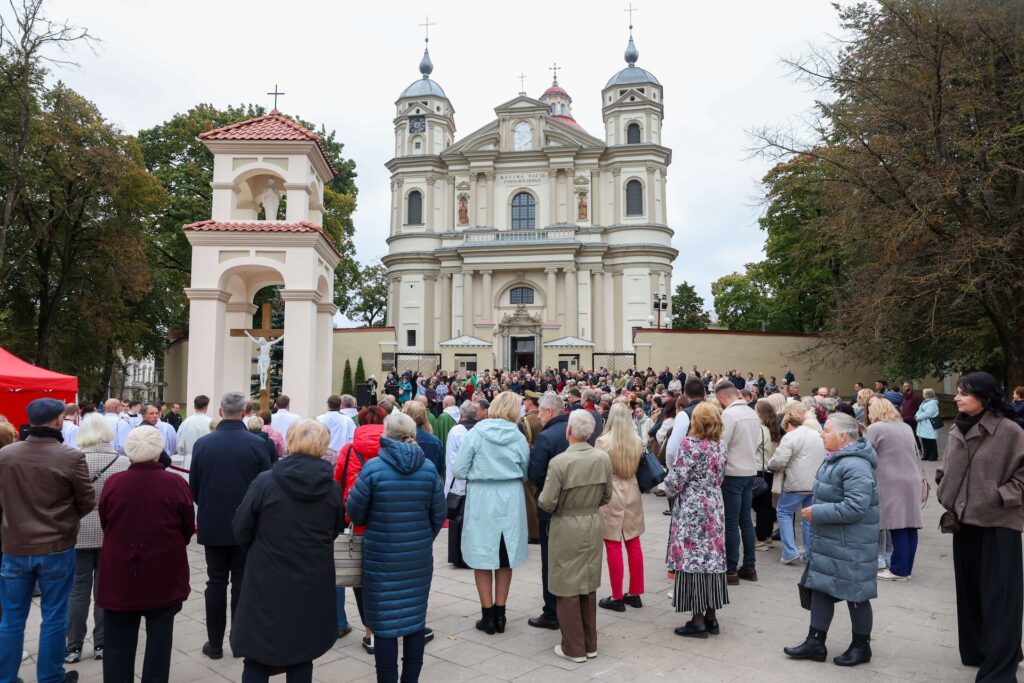Rebuilding the Chapel of the Lord Jesus in Vilnius - prehistory
The historic Chapel of the Lord Jesus, restored with the help of the Janukonis Fondas, has been erected in front of the Church of Saints Peter and Paul in Vilnius. What were the circumstances that led to the birth of this beautiful idea, which has become a reality and today is already delighting the residents of the capital and visitors to the city?
From idea to implementation
In June 2021, on the initiative of Česlovas Okincic, a signatory of the Act of Independence, Andrius Janukonis, the founder of the Foundation, met Wojciech Gorlicki, the dean of the parish of Saints Peter and Paul.
They discussed meaningful work for the church, the community and the city. Ideas were exchanged and the topic of rebuilding the Baroque chapel, which was destroyed during the Soviet era, came into focus. It was decided that it was worth looking into the possibility of restoring this historic chapel.
Architect Mečislovas Jagusinskis, who has a keen interest in the history of the Church of Saints Peter and Paul, came to assist. He set about verifying the facts and gathering information that enabled him to lay the groundwork for the restoration project of the Chapel of the Lord Jesus.
In January 2022, Fondas Janukonis and the church parish signed a support agreement for the restoration of the chapel. In this agreement, the Foundation undertook to cover 100% of the restoration costs and to help organise the design and restoration of the chapel.
The project took two years of coordination procedures with the relevant state authorities, and the building permit was granted in 2024. In the spring of the same year, work on the restoration of the chapel started. On 30 June, the foundations were consecrated and on 6 October, the Chapel of the Lord Jesus was officially opened.
Sincere thanks to those who contributed
The rebuilding of the chapel has brought together different people, without whom this project would not have seen the light of day. Sincere thanks to all those who spared no effort and energy to restore the historic Chapel of the Lord Jesus:
Česlav Okinčic, signatory of the Act of Independence;
Wojciech Gorlicki, parish priest;
Marek Rusakevič, Parish Administrator;
Mečislovas Jagusinskis, architect;
Darius Čeponis, architect;
Nerijus Kavaliauskas and Rūta Glinskytė – Kavaliauskienė, restorers and sculptors.
The chapel – next to a historical site
The Chapel of the Lord Jesus was demolished during the Soviet era, around 1953. In 1966, after the construction of the Žirmūnai Bridge, a roundabout was built at its junction with Antakalnis Street. It is therefore impossible to rebuild the chapel on its exact historical site.
According to the municipal company Vilniaus Planas, which in 2020 examined the possibility of redeveloping the church site, the appropriate location for the reconstruction of the Chapel of the Lord Jesus is the intersection of the axes of the current northern axis of T. Kosciuškos Street leading towards Antakalnis, the little street leading out of the monastery, and the main entrance to the churchyard. Thus, although the chapel is about 18 metres away from its exact historical location, it becomes the highlight of the square in front of the church.
„The Church of Saints Peter and Paul, one of the most beautiful churches in Vilnius, was built on the site of the temple of the ancient Lithuanian goddess Milda. A two-storey chapel stands in front of St Peter and Paul’s Church, right on the street. On the lower floor there is a wooden cross and on the upper floor there is a figure of Our Lady with a heart pierced by seven swords. There is no real knowledge of when this chapel was built. Around the middle of the 19th century, it was completely dilapidated; however, in 1866, it was renovated and a roof was added,” writes the book „Vilnius and its Surroundings”, 1937.


